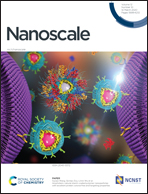Highly boosted gas diffusion for enhanced electrocatalytic reduction of N2 to NH3 on 3D hollow Co–MoS2 nanostructures†
Abstract
Transition metal chalcogenide MoS2 catalysts are highly selective for the electrochemical reduction of dinitrogen (N2) to ammonia (NH3) in aqueous electrolytes. However, due to the low solubility of N2 in water, limited N2 diffusion and mass transport have heavily restricted the yield and the faradaic efficiency (FE). Here, we have demonstrated a highly efficacious assembled gas diffusion cathode with hollow Co–MoS2/N@C nanostructures to significantly improve the electrochemical reduction of N2 to NH3. Our results revealed that the synthesized Co–MoS2 heterojunctions with abundant graphitic N groups exhibited a superb NH3 yield of 129.93 μg h−1 mgcat−1 and a high faradaic efficiency of 11.21% at −0.4 V vs. the reversible hydrogen electrode (RHE), as well as excellent selectivity and stability. The strategy described in this study offers new inspiration to design high-performance electrocatalyst assemblies for the sustainable environmental and energy applications.



 Please wait while we load your content...
Please wait while we load your content...